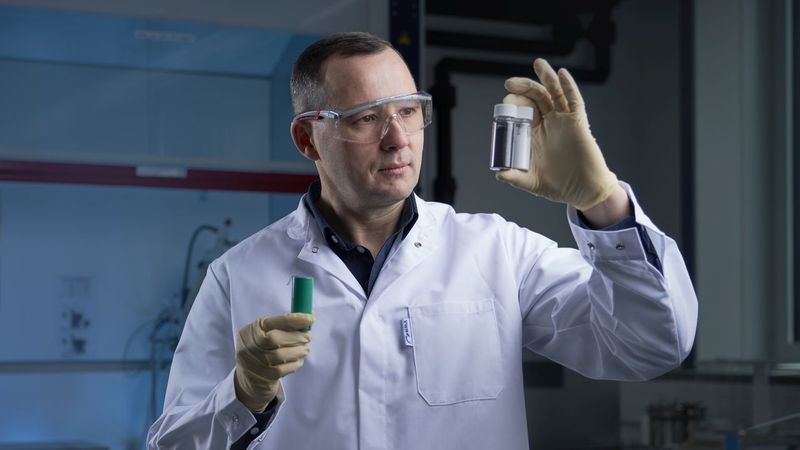Battery recycling: 70 percent of the lithium recovered
KIT researchers develop inexpensive and environmentally friendly mechanochemical recycling process - publication in Nature Communications Chemistry

dr Oleksandr Dolotko, lead author of the publication, conducts research at the IAM-ESS Institute and the HIU. (Photo: Amadeus Bramsiepe, KIT)
Recovering up to 70 percent of the lithium from battery waste without the need for corrosive chemicals, high temperatures or prior sorting of the materials: This is made possible by a recycling process developed at the Karlsruhe Institute of Technology (KIT) that combines mechanical processes and chemical reactions. The method allows a wide variety of lithium-ion batteries to be recycled in a cost-effective, energy-efficient and environmentally friendly manner. The researchers report in the journal Nature Communications Chemistry ( DOI: 10.1038/s42004-023-00844-2 )
Lithium-ion batteries permeate our everyday life: They not only supply notebooks and smartphones, toys, remote controls and other small devices with wireless power, but also act as the most important energy storage medium for the rapidly growing electromobility. The increasing use of these batteries calls for economically and ecologically sustainable recycling methods. Today, mainly nickel and cobalt, copper and aluminum as well as steel are recovered and recycled from battery waste. The recovery of lithium is currently still expensive and not very profitable. The available, mostly metallurgical processes consume a lot of energy and/or leave behind harmful by-products. In contrast, approaches in mechanochemistry, which use mechanical processes to bring about chemical reactions, promise
Suitable for different cathode materials
Such a method has now been developed by the Institute for Applied Materials - Energy Storage Systems (IAM-ESS) of KIT together with the Helmholtz Institute Ulm for Electrochemical Energy Storage (HIU) founded by KIT in cooperation with the University of Ulm and EnBW Energie Baden-Württemberg AG . In the journal Nature Communications Chemistrythe researchers present their method. You can achieve a recovery rate of up to 70 percent for the lithium without the need for corrosive chemicals, high temperatures or prior sorting of the materials. "The process is suitable for recovering lithium from cathode materials with different chemical compositions and is therefore suitable for many different commercially available lithium-ion batteries," explains Dr. Oleksandr Dolotko from the IAM-ESS of the KIT and from the HIU, main author of the publication. "It allows for cost-effective, energy-efficient and environmentally friendly recycling."
Reaction takes place at room temperature
For their process, the researchers use aluminum as a reducing agent in the mechanochemical reaction. Since aluminum is already contained in the cathode, the process does not require any additional substances. How it works: The battery waste is first ground up. Then they are used in a reaction with aluminum to create metallic composites with water-soluble lithium compounds. The lithium is then recovered by dissolving the water-soluble compounds in water and then heating to remove the water through evaporation. Since the mechanochemical reaction takes place at ambient temperature and pressure, the process is particularly energy-efficient. Another advantage is the simple process, which will facilitate use on an industrial scale.

Original publication (Open Access)
Oleksandr Dolotko, Niclas Gehrke, Triantafillia Malliaridou, Raphael Sieweck, Laura Herrmann, Bettina Hunzinger, Michael Knapp & Helmut Ehrenberg: Universal and efficient extraction of lithium for lithium-ion battery recycling using mechanochemistry. Communications Chemistry, 2023. DOI: 10.1038/s42004-023-00844-2